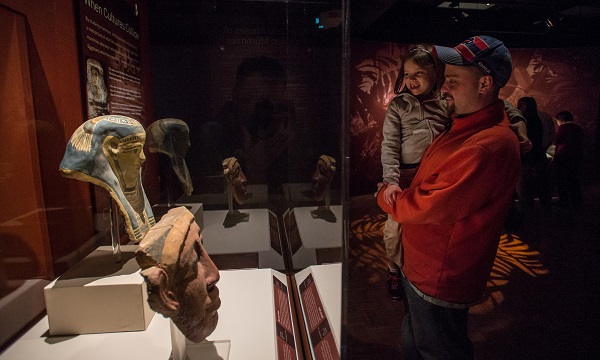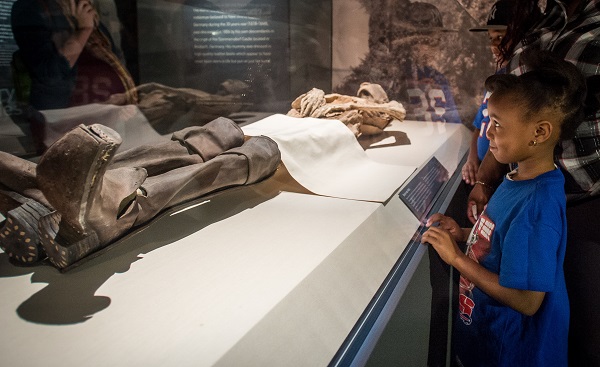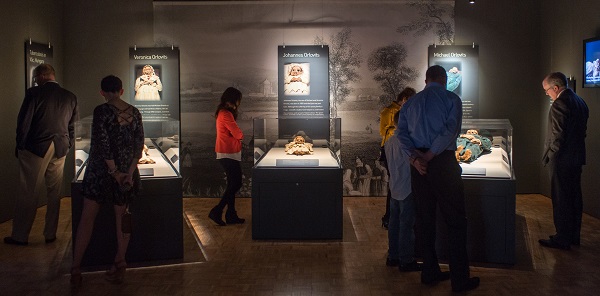
5 reasons to get kids wrapped up in ‘Mummies of the World’ in Pittsburgh
Donna Westrich talks to the dead.
As general manager of “Mummies of the World: The Exhibition,” she travels with 40 human and animal mummies. Over the years, she’s grown attached to them and strikes up one-sided conversations each time they get ready to hit the road.
“They are human beings,” she says. “They didn’t live the way we do now, but they need to be treated with dignity and respect.”
The mummies will be on display in at the Carnegie Science Center from Oct. 5 through April 19. They provide a wealth of information in anthropology, archaeology, medicine and history. Thinking of a family visit? Read this first.
1. What is a mummy anyway?
Mummification is the process where some of the soft tissues of a deceased body — skin, muscle, internal organs, hair, nails — are preserved through intentional and natural methods. The specimens at the Science Center come from Egypt, Europe and South America.
Studying these bodies with the latest technology gives us insight into ancient peoples, environments and civilizations, down to what they ate. There’s even a man who willed his body to science in Maryland in 1994 and was mummified using a 2,800-year-old Egyptian technique.
Preserving the remains is still a concern. All the mummies’ cases are temperature-controlled with monitors that staff check throughout each day to ensure ideal conditions.
2. Is the exhibit OK for kids?
Children are most fascinated by the shrunken heads and mummified animals, Westrich says. Not sure if your child will be freaked out? The Science Center offers a family guide to the exhibit, giving moms and dads advice on how to explain the subject matter to kids before your visit. A discussion on what to expect will enrich the experience. A learning guide for teachers is also available. The lessons will be a terrific primer for those planning field trips.
3. Any cool activities?
Kids will learn about mummies and the process of mummification through hands-on interactive stations, cutting-edge 3-D animation and state-of-the-art multimedia. Watch the events calendar for updates on special programs, such as the chance to hear from archeologists and other experts.
4. How can a body be naturally mummified?
We think of mummies as Egyptian royalty, wrapped in fabric and buried in pyramid vaults. But under optimal conditions, bodies can be mummified over time. For example, bodies buried in an acidic peat bog or a sand-salt environment, or frozen in an alpine glacier will remain preserved for many years.
Take a look at the Orlovits family from Vác, Hungary, a small town near the Danube River just north of Budapest. Michael, Johannes and Veronica Orlovits are among 265 18th-century bodies discovered in 1994 during repair work in the town’s Dominican Church crypt. The cool, dry air of the long-forgotten tomb, combined with the oil from the pine boards used to make the elaborate coffins, prevented fungi and bacteria from forming and breaking down the body tissues.
Learn more in the Natural Mummification Gallery.
5. So, what can kids get out of a visit?
“Mummies of the World” piques a child’s curiosity. A visit might inspire kids to pursue careers in science or anthropology, says Ildiko Szikossy of the Hungarian Natural History Museum in Budapest. She has been studying the Vác Mummies for 25 years.
She encourages Pittsburghers young and old to visit before the exhibit wraps up next spring.
Death, after all, is a part of life.
“We cannot close our eyes to it,” she says.


